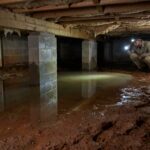Essential Guide to Choosing the Right Foundation Repair Method for Your Home
When it comes to maintaining your home, the foundation is the unsung hero. It’s the sturdy platform that supports everything else above it. But what happens when that foundation starts to falter? Cracks appear, doors stick, and suddenly your once peaceful abode resembles a set from a horror movie. Fear not! This guide will walk you through the essential steps to choose the right foundation repair method to restore your home’s stability—and maybe even save the day.
Understanding Foundation Problems
First, let’s discuss the signs of foundation issues. You may not be the next Sherlock Holmes, but discerning these clues is key to ensuring your home doesn’t go toppling over like a Jenga tower. Common indicators include:
1. **Cracks in Walls**: These can range from tiny hairline fractures to gaping holes that make you question whether your house is auditioning for a disaster film.
2. **Uneven Floors**: If walking across your living room feels like navigating a funhouse, it’s time to investigate.
3. **Doors and Windows That Stick**: If you have to shove your front door to get it open, it may be time to reassess your foundation’s health.
4. **Gaps Between Walls and Ceilings**: If these spaces are growing wider than your last family gathering’s arguments, you might have a problem.
Now that you’ve identified potential issues, let’s explore how to address them.
Foundation Repair Methods Overview
There isn’t a one-size-fits-all answer to foundation repair. Different situations call for different solutions, and thankfully, there are a variety of methods available. Here’s an overview of some common foundation repair techniques:
### 1. Piering and Piling
When your foundation has settled due to soil erosion or other factors, piering and piling techniques can offer a lifeline. This method involves drilling deep into the ground beneath your home to stabilize it. Think of it as giving your house a much-needed boot camp experience, helping it regain its strength.
– **Helical Piers**: These are screw-like steel piers that are driven deep into stable soil. They’re great for lighter structures like porches and additions.
– **Push Piers**: These are pushed into the ground with hydraulic equipment and can bear heavy loads. Perfect for lifting and stabilizing heavier areas of your home.
### 2. Slabjacking
If you have a concrete slab foundation that has sunk in certain areas, slabjacking could be your knight in shining armor. This method involves pumping a special mixture beneath the slab to lift it back to its original position. It’s like giving your foundation a good fitness regime—lifting weights and looking good!
### 3. Wall Anchors
In cases where basement walls are bowing due to soil pressure, wall anchors can provide the support they need. This method utilizes steel plates to anchor the walls, pulling them back into alignment. It’s like giving your walls a supportive hug to keep them from leaning too far.
### 4. Waterproofing Solutions
Sometimes, the problem isn’t the structural integrity but rather the moisture levels in the soil surrounding your foundation. Excess water can lead to issues like mold growth and further foundation damage. Waterproofing solutions, such as exterior drainage systems or sealants, can help manage water levels and keep your foundation dry. Think of it as giving your home a stylish raincoat.
### 5. Grouting and Injection
Similar to the long-term relationship you may have with your dentist, this technique involves filling cracks and voids with grout or epoxy injections. It’s a less invasive option and can be quite effective for smaller fissures. After all, who wants to deal with a major overhaul when a simple filling will do?
### 6. Retaining Walls
If your home is situated on a slope or hill, retaining walls can bolster your foundation by holding back soil and reducing pressure on the base. It’s like building a fortress around your house—who wouldn’t feel more secure with that?
Choosing the Right Method
With all these options, how do you decide which foundation repair method is best for your home? Here are some critical considerations:
#### 1. Assess the Damage
Before making any decisions, it’s essential to assess the damage thoroughly. Take note of the type and extent of the cracks, slope of floors, and any other symptoms you’ve noticed. Consider bringing in a professional inspector who knows their stuff. It’s worth spending a bit more upfront to avoid costly mistakes down the line.
#### 2. Consult the Experts
Don’t shy away from seeking professional assistance. Consult with foundation repair specialists who can provide insights tailored to your specific situation. A qualified contractor will conduct a thorough analysis and suggest the most effective methods for your needs. Think of them as the wise sages guiding you on your home repair adventure.
#### 3. Consider Your Budget
Foundation repair can be a significant investment, so it’s vital to align your choices with your budget. Some methods, like slabjacking, can be more affordable than full foundation replacements, but prices may vary based on severity. Get multiple quotes to ensure you’re getting the best bang for your buck.
#### 4. Think Long Term
When choosing a repair method, consider the long-term implications. Will the chosen solution hold up against potential future problems? An initial cheaper fix might cost you more in the long run if it doesn’t address the root cause effectively.
#### 5. Check Warranty Options
Some repair methods come with warranties. Be sure to inquire about these guarantees before committing. A solid warranty can give you peace of mind, knowing that if the problem resurfaces, you won’t be left footing the bill for repairs again.
Maintaining Your Foundation
Once you’ve successfully chosen and implemented a foundation repair method, it’s vital to regularly maintain your foundation. Here are some maintenance tips to keep your foundation healthy:
– **Control Water Drainage**: Ensure proper drainage around your home. Gutters should direct water away from the foundation, and downspouts should extend several feet from the base. Think of water as a mischievous gremlin; you want to keep it away from your beloved home.
– **Landscaping Choices**: Avoid planting large trees close to your foundation. Their roots can create havoc underground, but they might look great in your yard. It’s a tough choice!
– **Monitor for New Cracks**: Regularly inspect your walls and floors for new cracks, especially after heavy rain or drought periods. A proactive approach can save you headaches later.
– **Maintain Consistent Moisture Levels**: Depending on your climate, maintaining appropriate moisture levels around your foundation is key. Too much or too little can lead to shifts in soil that may affect stability.
Conclusion
Choosing the right foundation repair method for your home doesn’t have to be a daunting task. With a little knowledge, a sharp eye for detail, and perhaps some guidance from professionals, you can ensure your home remains safe and sound. Remember, taking action at the first sign of trouble is always better than waiting until you have an uninvited guest—like a massive crack—strolling through your living room. So roll up those sleeves, take a deep breath, and prepare to give your home’s foundation the care it deserves!


